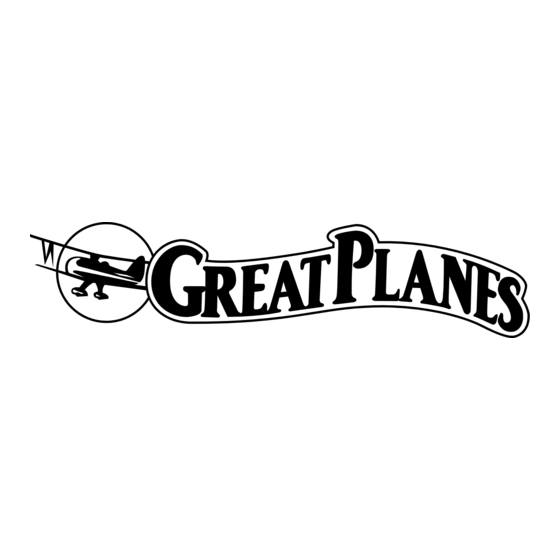GREAT PLANES Piper j-3 cub Instruction Manual - Page 13
Browse online or download pdf Instruction Manual for Toy GREAT PLANES Piper j-3 cub. GREAT PLANES Piper j-3 cub 16 pages. Electrifly series
Also for GREAT PLANES Piper j-3 cub: Instruction Manual (6 pages)

AMA SAFETY CODE (excerpts)
Read and abide by the following excerpts from the Academy
of Model Aeronautics Safety Code. For the complete Safety
Code refer to Model Aviation magazine, the AMA web site or
the Code that came with your AMA license.
1) I will not fly my model aircraft in sanctioned events, air
shows, or model flying demonstrations until it has been
proven to be airworthy by having been previously,
successfully flight tested.
2) I will not fly my model aircraft higher than approximately
400 feet within 3 miles of an airport without notifying the
airport operator. I will give right-of-way and avoid flying in the
proximity of full-scale aircraft. Where necessary, an observer
shall be utilized to supervise flying to avoid having models
fly in the proximity of full-scale aircraft.
3) Where established, I will abide by the safety rules for the
flying site I use, and I will not willfully and deliberately fly my
models in a careless, reckless and/or dangerous manner.
5) I will not fly my model unless it is identified with my name
and address or AMA number, on or in the model. Note: This
does not apply to models while being flown indoors.
7) I will not operate models with pyrotechnics (any device
that explodes, burns, or propels a projectile of any kind).
Radio Control
1) I will have completed a successful radio equipment ground
check before the first flight of a new or repaired model.
2) I will not fly my model aircraft in the presence of
spectators until I become a qualified flier, unless assisted by
an experienced helper.
3) At all flying sites a straight or curved line(s) must be
established in front of which all flying takes place with the
other side for spectators. Only personnel involved with flying
the aircraft are allowed at or in the front of the flight line.
Intentional flying behind the flight line is prohibited.
4) I will operate my model using only radio control frequencies
currently allowed by the Federal Communications Commission.
5) I will not knowingly operate my model within three
miles of any pre-existing flying site except in
accordance with the frequency sharing agreement
listed (in the complete AMA Safety Code).
General
9) Under no circumstances may a pilot or other person touch
a powered model in flight; nor should any part of the
model other than the landing gear, intentionally touch
the ground, except while landing.
CHECK LIST
During the last few moments of preparation your mind may
be elsewhere anticipating the excitement of the first flight.
Because of this, you may be more likely to overlook certain
checks and procedures that should be performed before the
model is flown. To help avoid this, a check list is provided to
make sure these important areas are not overlooked. Many
are covered in the instruction manual, so where appropriate,
refer to the manual for complete instructions. Be sure to
check the items off as they are completed.
❏
1. Check the C.G. according to the measurements
provided in the manual.
❏
2. Be certain the battery and receiver are securely
mounted to the fuselage.
❏
3. Confirm that all controls operate in the correct direction
and the throws are set up according to the manual.
❏
4. Check the operation of the motor and gearbox prior to
each flight.
❏
5. Make sure that all servo arms are secured to the
servos with the screws included with your radio.
❏
6. Place your name, address, AMA number and
telephone number on or inside your model.
❏
7. If you wish to photograph your model, do so before
your first flight.
❏
8. Range check your radio when you get to the flying field.
❏
9. Confirm that the hinge tape is properly secured.
The FlatOuts J-3 Cub is a good flying indoor model.
However, it is not a trainer. Flying the airplane requires the
use of the ailerons, elevator and rudder. If you are not
proficient with using the rudder, it is recommended that you
practice flying the model outdoors in a 1 to 2 mph wind
before taking it into a confined indoor flying site.
For your first flight you may wish to have someone launch
the airplane so that you can concentrate on trimming it. After
the airplane is properly trimmed, you should be able to
easily hand launch the plane and fly the plane yourself. To
hand launch, apply full power and gently toss the plane into
the air.
13
